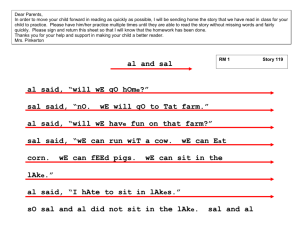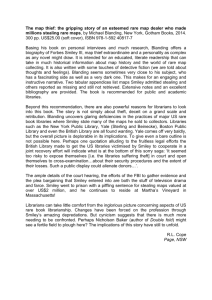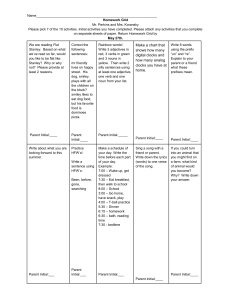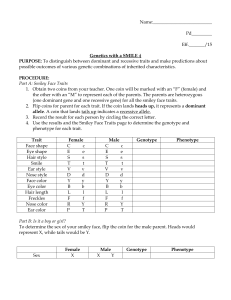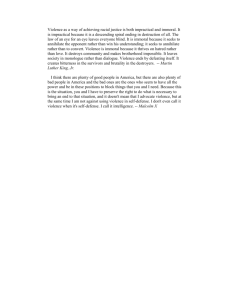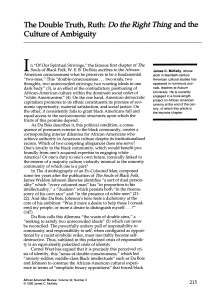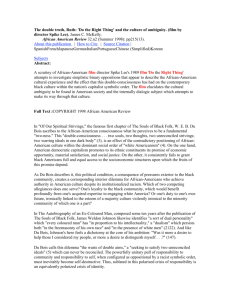Violence as a way of achieving racial justice is
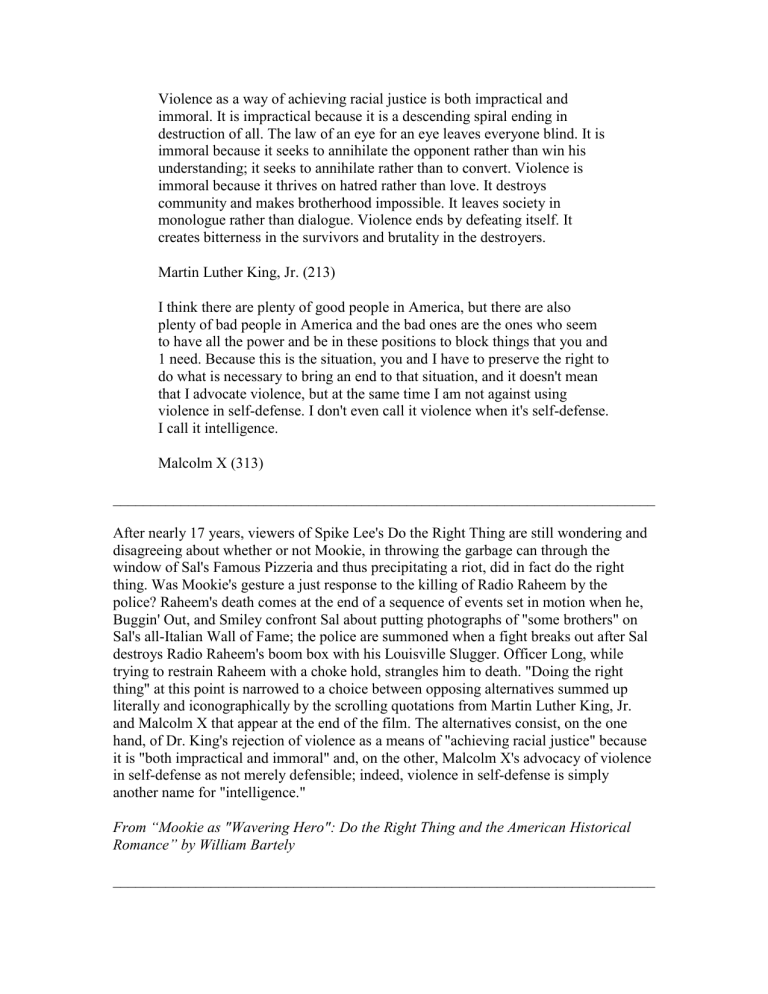
Violence as a way of achieving racial justice is both impractical and immoral. It is impractical because it is a descending spiral ending in destruction of all. The law of an eye for an eye leaves everyone blind. It is immoral because it seeks to annihilate the opponent rather than win his understanding; it seeks to annihilate rather than to convert. Violence is immoral because it thrives on hatred rather than love. It destroys community and makes brotherhood impossible. It leaves society in monologue rather than dialogue. Violence ends by defeating itself. It creates bitterness in the survivors and brutality in the destroyers.
Martin Luther King, Jr. (213)
I think there are plenty of good people in America, but there are also plenty of bad people in America and the bad ones are the ones who seem to have all the power and be in these positions to block things that you and
1 need. Because this is the situation, you and I have to preserve the right to do what is necessary to bring an end to that situation, and it doesn't mean that I advocate violence, but at the same time I am not against using violence in self-defense. I don't even call it violence when it's self-defense.
I call it intelligence.
Malcolm X (313)
________________________________________________________________________
After nearly 17 years, viewers of Spike Lee's Do the Right Thing are still wondering and disagreeing about whether or not Mookie, in throwing the garbage can through the window of Sal's Famous Pizzeria and thus precipitating a riot, did in fact do the right thing. Was Mookie's gesture a just response to the killing of Radio Raheem by the police? Raheem's death comes at the end of a sequence of events set in motion when he,
Buggin' Out, and Smiley confront Sal about putting photographs of "some brothers" on
Sal's all-Italian Wall of Fame; the police are summoned when a fight breaks out after Sal destroys Radio Raheem's boom box with his Louisville Slugger. Officer Long, while trying to restrain Raheem with a choke hold, strangles him to death. "Doing the right thing" at this point is narrowed to a choice between opposing alternatives summed up literally and iconographically by the scrolling quotations from Martin Luther King, Jr. and Malcolm X that appear at the end of the film. The alternatives consist, on the one hand, of Dr. King's rejection of violence as a means of "achieving racial justice" because it is "both impractical and immoral" and, on the other, Malcolm X's advocacy of violence in self-defense as not merely defensible; indeed, violence in self-defense is simply another name for "intelligence."
From “Mookie as "Wavering Hero": Do the Right Thing and the American Historical
Romance” by William Bartely
________________________________________________________________________
What is ultimately at stake in Do the Right Thing is a kind of person, a young black male kind, a kind who is not offered protection from the law, a kind instead whom others
(read: white people) feel they need protection from. As Spike Lee has said. Mookie's initiation of the destruction of Sal's is not just Mookie's: "It's that whole community. The horror of seeing Radio Raheem murdered before their own eyes. The horror of knowing this isn't the first time something like this has happened, that this won't be the last time.
It's a complete frustration with justice never being attained."
Alas, the other favorite peeve of the critics -- Lee's irresponsible suggestion that Mookie did the right thing (vis-a-vis Malcolm X's infamous self-defense quote scrolled across the screen after the action). I missed something.
In the final analysis, we, the audience, are supposed to decide if the destruction of Sal's is a reasonable reaction to this loss of life, a reasonable reaction to unreasonable circumstances. We are challenged to place blame and to decide who, if anyone, did the right thing.
In fact, the beauty in this film is the frustration of never being sure who did do the right thing. Throughout the film, this same tension informs every character and every relationship. It is at the core of this movie, and we feel it. Marvel at it, really. This whole agitated series of tiny events that produce an enormous event, this chain of stimulus and response that is behind every headline from Howard Beach to Virginia Beach.
Long before this film opened, Spike Lee proclaimed Public Enemy's "Fight the Power" theme song of the summer. Several summers ago, Grand Master Flash and The Furious
Five issued a similar musical decree with their "Don't Push Me Cause I'm Close to the
Edge."
We didn't listen then either.
From “IN SAL`S COUNTRY” by Jacqule Jones is the editor of Black Film
Review.
________________________________________________________________________
The character who intrigues me the most in Do the Right Thing is Smiley (Roger
Guenveur Smith). Described by some as the "village idiot," he is clearly the most politically conscious person in the film. He puts the political and cultural icons of
Malcolm X and Martin Luther King together on a xerox postcard which he hand-colors and sells; in his solo introduction, he proclaims that though Martin and Malcolm are dead, we must stop apartheid. At the end it is Smiley, vocally challenged, who takes the match and sets Sal's Pizzeria on fire. But to the rest of the people on the block, Smiley is simply a nuisance. Although Mookie (Lee's character) is rude to the ever persistent
Saturday morning Jehovah Witnesses to whom he barks, "Hell no!", Smiley is not so easily written off.
Smiley's role in the film makes a sharp comment about leadership in the black community. Though there are those who claim to be leaders, like Buggin' Out (read Al
Sharpton), there are others like Da Mayor (read Black Elders) and Smiley to whom little or no attention is paid because they are not quite so glamorous in their approach. These characters, who are types for countless other `real' people, give the black community its mouthpiece, but are not always listened to or taken seriously.
Smiley also appears at a pivotal point in the film when Sal and Pino are in heavy discussion about the neighborhood where they work. While Sal gloats about "these people" being raised on his pizza, Pino complains that "these people" are "animals." Just at this moment, Smiley appears, trying to hawk one of his postcards. Pino, still young and hotheaded, yells at Smiley to get away from the shop. This outburst causes the corner men to rise vocally in Smiley's defense. Sal, a more experienced man in human relations, knows that he has to keep peace in order to survive. He goes out of his shop to give
Smiley a couple of dollars, not because he wants one of Smiley's postcards, but rather to appease the community and to show his concern and benevolence towards them. The veil of thought that black people are animals or children is much more subtly hidden in Sal, rather than in his angry son Pino, but the underlying racist attitudes still exist.
One of the interesting things about Do the Right Thing is that its subject matter shocked and reawakened America to the fact that racism inherent to the workings of this country and to the prejudice and the lack of dialog that exists between people of various cultures living in the United States, as detailed by the racial slur montage. The film provokes an audience to discussion and not to rioting, as many members of the mainstream press thought it would.
From “BLACK INDEPENDENT OR HOLLYWOOD ICONOCLAST?” by
Zelnabu Irene Davis, an independent filmmaker, teaches at Antioch College.
________________________________________________________________________
Creative tensions operate on every level of Do the Right Thing. The film's dialectics work most pervasively and effectively in the very area where mainstream journalists have accused it of being confused --politics. The two poles of political action are embodied by
Martin Luther King with his call for nonviolence and Malcolm X with his assertion that violence is sometimes necessary (or mare precisely, when done in self-defense should not he called violence). These two political philosophies are not choices to be made, but insights to be embraced and synthesized. This message is carried, ironically, by the two most unlikely characters in the film: Smiley (Roger Smith) and Radio Raheem (Bill
Nunn). Their names resonate with the visual and the aural; it is on these levels that each respectively operates.
Smiley is enchanted by a portrait of King and Malcolm X standing together, smiling.
Their comfort with each other and the very fact that they can coexist within the frame recur as a powerful icon over the course of the film. Radio Raheem, who walks around with his boom box playing the song "Fight the Power," explains how they coexist when he breaks into unexpected eloquence. Displaying his brass knuckles which spell out the
words L-O-V-E and H-A-T-E, he tells a story of the right hand and the left. "When the left hand (hate) is kicking much ass and it looks like right hand love is finished . . . love comes roaring back. Wham. Wham. KO'ed by love." These forces may be opposed to each other on one level but on another they are forces for change. Both thesis and antithesis are necessary in the struggle for liberation and racial equality.
Mookie lives on the edge as he struggles not to choose but to balance the conflicting demands of solidarity with fellow African-Americans and involvements with nonblacks, of loving and fighting, of work and family. These tensions saturate Mookie's two most important relationships (important by the very nature of their uncertainty): with Sal
(Danny Aiello), the Italian who owns the local pizzeria where he is employed delivering pies, and Tina (Rosie Perez), his Hispanic girlfriend and the mother of his child. Both demand his principal attention; keeping each happy enough so that he does not lose either job or family is a trick.
From “L-O-V-E AND H-A-T-E” by Charles Musser (teacher of Film Studies at
NYU and Columbia .

